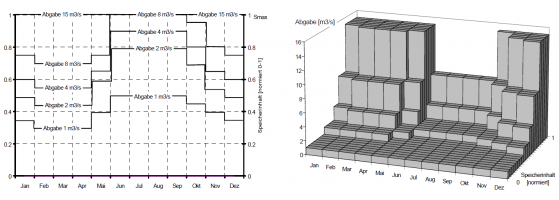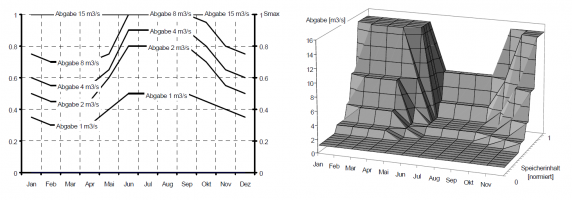Speicher/en: Unterschied zwischen den Versionen
Ferrao (Diskussion | Beiträge) (Die Seite wurde neu angelegt: „The physically maximum possible output can also be entered for the individual ou…“) |
Ferrao (Diskussion | Beiträge) (Die Seite wurde neu angelegt: „===Internal dependencies===“) |
||
| Zeile 94: | Zeile 94: | ||
=== | ===Internal dependencies=== | ||
Über Interne Abhängigkeiten werden die [[Betriebsregeltypen#Regel_Typ_9:_Priorit.C3.A4ten_bei_mehreren.2C_konkurrierenden_Abgaben_aus_einem_Speicher|Prioritäten bei mehreren, konkurrierenden Abgaben aus einem Speicher]] definiert. Dabei können eine oder mehrer Abgaben reduziert werden, wenn eine andere Abgabe einen bestimmten Betrag überschreitet oder der Speicherinhalt einen bestimmten Betrag unterschreitet. | Über Interne Abhängigkeiten werden die [[Betriebsregeltypen#Regel_Typ_9:_Priorit.C3.A4ten_bei_mehreren.2C_konkurrierenden_Abgaben_aus_einem_Speicher|Prioritäten bei mehreren, konkurrierenden Abgaben aus einem Speicher]] definiert. Dabei können eine oder mehrer Abgaben reduziert werden, wenn eine andere Abgabe einen bestimmten Betrag überschreitet oder der Speicherinhalt einen bestimmten Betrag unterschreitet. | ||
Version vom 17. November 2020, 14:10 Uhr
50px|none|Symbol Systemelement Speicher
Reservoirs are used to store an inflow and, depending on the current content and operating regulations, to deliver water for a total of newly different uses to up to three different system elements. With the possibility to regulate and control it is an extremely flexible system element with a variety of options. Originally, the reservoir was developed to represent dams, but it is also possible to represent other reservoirs such as flood control reservoirs or similar. Optionally, an addition to the reservoir by precipitation, as well as losses at the reservoir by evaporation and infiltration can be simulated.
The system element Reservoir can also be used to simulate hydro power plants.
Storage characteristic
The storage characteristic curve compares the content of the storage tank with the respective water levels and the surface. It is the basis for all calculation options that include not only the reservoir content but also the height or surface, e.g., feed/loss, weir, pressure pipe.
Release
Calculation options
Independent of the selected calculation option, the outputs can still be scaled with a system state/state group, which makes it possible to integrate complex operating rules, which are not only dependent on states within the storage element, but also on states within the entire river basin.
Output per time step/output sequence
With this option, you define the output values by directly entering output values (up to 365). These output values are output in this order for one time step at a time during the simulation.
Function ( + Graph/Time series)
The outputs are defined as content-dependent functions through the input of grid points. These outputs can additionally be scaled with a factor, a yearly, weekly and daily cycle (and, as with all calculation options, with a system state or a state group) or with a factor and a time series.
The following options are available as function types:
|
KNL |
Kennlinie |
|
LAM |
Lamellenplan |
|
XYZ |
Zeitabhängige Funktion |
Characteristic curve
For the characteristic curve, a time-independent content delivery function is entered. The interpolation points can be interpreted as steps or interpolated linearly.
Lamellenplan
With the option Lamella plan the storage content is divided into different areas (lamellas) over the year and these lamellas are each assigned a fixed delivery level. Thus, any ascending delivery levels are defined and for each fixed period of time the respective storage contents are entered for each of these delivery levels.
The supporting points of the lamella plan can be interpreted as block steps. However, it is also possible to interpolate linearly in time and/or to interpolate linearly between the grid points of the contents/output values.
Time dependent function
The time dependent function is very similar to the slat plan, but a bit more flexible: The support points for the output values must be the same for the different time periods only in number, but not in value, and they do not necessarily have to be ascending. So you can define arbitrary functions with their respective content and output values for different time periods.
By default the entered interpolation points are interpreted as block steps. However, it is also possible to interpolate linearly in time and/or to interpolate linearly between the grid points of the contents/output values.
Weir raid
The charge is calculated by the weir formula according to Poleni as a perfect / imperfect raid.
Pressure pipeline
The fee is calculated using the Prandtl-Colebrook and Darcy-Weisbach rates.
Turbine
Based on the characteristics of the turbine, the turbine flow is determined depending on the storage tank content and the underwater level, so that the desired performance is maintained as long as the maximum possible flow rate of the outlet is not exceeded. See also the page on hydropower plants.
Boundaries
The physically maximum possible output can also be entered for the individual outlet organs of the storage tank as a function of the storage tank content, which additionally limits the desired outputs. A minimum permissible discharge can also be entered here, below which the discharge is set to 0.
Internal dependencies
Über Interne Abhängigkeiten werden die Prioritäten bei mehreren, konkurrierenden Abgaben aus einem Speicher definiert. Dabei können eine oder mehrer Abgaben reduziert werden, wenn eine andere Abgabe einen bestimmten Betrag überschreitet oder der Speicherinhalt einen bestimmten Betrag unterschreitet.
Die jeweiligen Grenzen von Abgabe und Speichervolumen für die interne Abhängigkeiten sind Konstanten, die noch mit konstanten Ganglinien skaliert werden können.
Bei der Reduktion von mehreren Abgaben ist zudem die Reihenfolge anzugeben, in der reduziert werden soll.
Beispiel: Wenn Abgabe B > 0 und der Speicherinhalt S < X, dann reduziere Abgabe A um den Betrag der Abgabe B, wobei Abgabe A nicht kleiner als Null werden darf.
Das bedeutet, dass zwischen A und B eine lineare Abhängigkeit solange existiert, bis B gleich dem Wert von A ist. Steigt B weiter an, bleibt A konstant Null.
Zuschuss/ Verlust am Speicher
Einen Zuschuss oder Verlust am Speicher in Form von Niederschlag, Verdunstung oder Versickerung kann über zwei Optionen berücksichtigt werden:
- Konstante Ganglinie (Tages,- Wochen- und/oder Jahresgang)
- Zeitreihe
Diese können jeweils noch mit einem Faktor skaliert werden. Der speichereigene Verlust/Zuschuss wird zusätzlich noch automatisch mit der aktuellen Speicheroberfläche skaliert.

